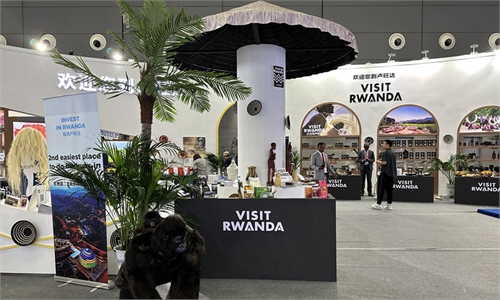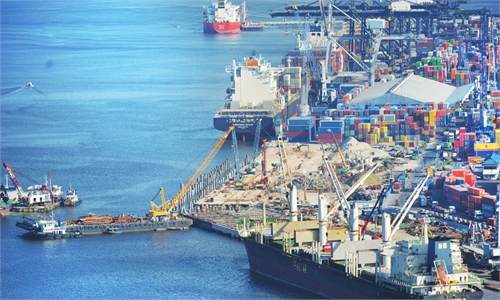IN-DEPTH / IN-DEPTH
GT investigates: Expectations for Chinese projects are burning bright in Southeast Asia, dismissing Western-driven hegemonic mindset traps
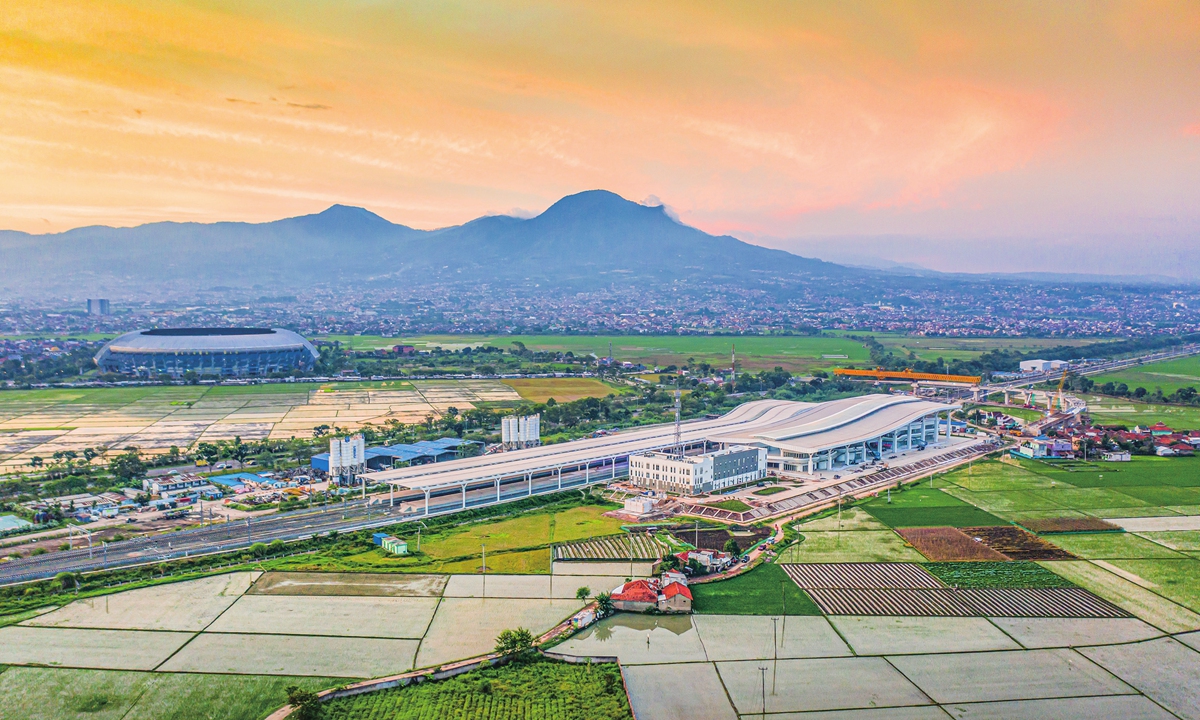
An aerial view of the Tegalluar station, the end point of the Jakarta-Bandung High-speed Railway Photo: Ren Weiyun
Akbar Fernando Ndabung, an Indonesian student in his 20s at the Udayana University and a local singer, did not expect his rap song about the Jakarta-Bandung High-speed Railway (HSR) to become an immediate hit on social media when it was released online in December 2022. The high tempo song is peppered with romantic lyrics interwoven into a rosy blue print of Indonesia.
When the Jakarta-Bandung HSR, with a design speed of 350 kilometers an hour, commences operation, the travel time between the capital of Jakarta and its fourth-largest city Bandung in West Java Province will be shortened from three hours to 40 minutes. Indonesia's capital of Jakarta is notorious for being among the cities with the worst traffic congestion in the world.
The positive feedback has inspired him to keep an eye on the HSR's latest development, and he plans to write more songs as the railway's public operation date draws near. "I'm breathlessly looking for any chance to be among the first group of passengers taking a ride on the HSR," Fernando noted.
Like him, there has been a palpable sense of excitement among Indonesians in recent days, as expectations are burning bright that the country will become the first in Southeast Asia to boast of a fully operational high-speed railway line.
Joining the buzz, Indonesian social media celebrities and nearby residents along the railroad, regularly record the HSR's testing at a "hotspot" mountain site near the terminal Tegalluar station and give updates on the project's latest developments.
"In addition to the operation of the first HSR, we also hope that China and Indonesia will join hands to extend the new railway to Surabaya, the country's second-largest city in East Java Province," Fernando said.
The earnest expectation displayed among the people in Indonesia, where the original proposal for the Belt and Road Initiative (BRI) was revealed a decade ago, comes as local skepticism and concerns about BRI projects have steadily been losing ground in the face of the 10th anniversary of the initiative. At a time when multiple BRI projects are gear up and entering the sprint stage, it also sends a resounding signal that the West's intensified smear campaign against the BRI has been in vain.
Over the last 10 years, Western countries have coined numerous terms to denigrate BRI projects in Southeast Asia, from the cliché of "debt trap" rhetoric, hypes of "economic colonization," doubts on projects' environmental sustainability and construction quality, to a recently invented subject, "sunk cost fallacy trap."
However, the Global Times' recent visits to a galaxy of BRI projects in Southeast Asia nations, including those in Indonesia, Malaysia, and Thailand, found such narratives were unwarranted. They were part of a US-led geopolitical game that aims to instigate anti-China sentiments and create discourse to obstruct otherwise normal economic cooperation under the promising initiative.
While the expanding network of mutually beneficial cooperation under the BRI should have been welcomed and hailed on the global stage, certain Western countries' kneejerk hostility toward the BRI tide has unmasked their "sour grapes" mentality, industry insiders noted.
The accusations levied against the China-proposed initiative have also laid bare the deeply-rooted hegemonic and Western-centric mindset of the certain Western countries, in particular the US, that reflexively imagine that actions taken by China are replicas of its unscrupulous colonial model.
Under Washington's approach, it unilaterally imposes its own will on recipient countries and issues loans with political strings attached, with the ulterior aim of pocketing US streams of revenue at the cost of cooperative partners' interests. It is vastly different from the BRI cooperation platform, which exemplifies the adage "teach a man to fish and you feed him for a lifetime," and genuinely leads to new growth and enhanced capacities for self-driven development in BRI countries.
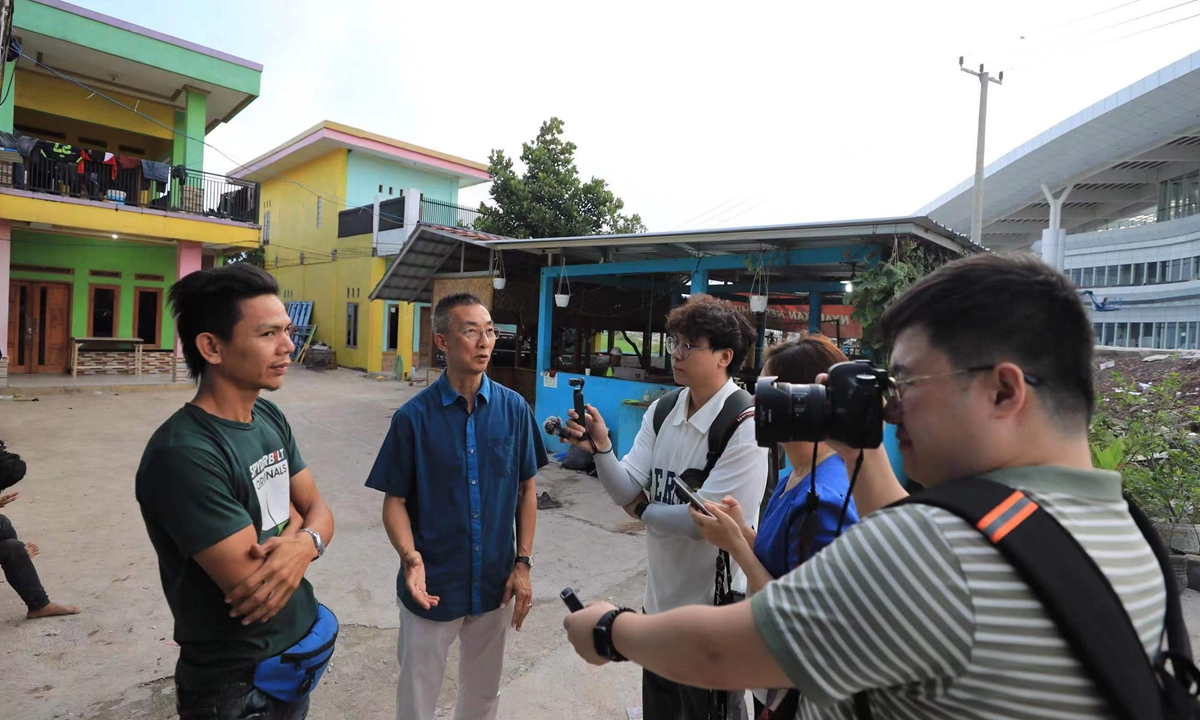
Residents living nearby the end station of the Jakarta-Bandung High-speed Railway line share their expectations for the project with Global Times reporters, in Bandung, Indonesia on July 9, 2023. Photo: Ren Weiyun
Steering through the choppy water
"It is important that we maintained a strategic focus and are committed to doing the work. Step by step, the positive development of BRI projects is set to burst every lie," said Zhang Chao, executive director of the board of PT Kereta Cepat Indonesia China (KCIC), when summarizing the last eight years of hard work that have put Western naysayers to shame.
The KCIC is a consortium of Indonesian and Chinese firms responsible for developing and operating the Jakarta-Bandung HSR line. Zhang is a founding board member of the KCIC, present since the joint venture was set up in 2015.
Looking outside Zhang's office in the KCIC building in Jakarta, the HSR's inaugural station - Halim Station - is within view, with dozens of local workers on the lattice roof, working in full swing to finish the project.
Zhang saw how the Halim Station was built from scratch. And the beginning is always the most difficult.
Back in 2015 and 2016, Zhang said the implementation of the project faced tremendous hardships, in particular from the local community, which at the time, showed a certain level of distrust, partly due to Western propaganda schemes.
"We received a lot of complaints at that time. Protestors even demonstrated in front of our office building. Some locals remained skeptical of whether Chinese bidders could perform better than Japanese bidders in railway technology," Zhang recalled, adding that doubts grew further with the Western-driven "debt trap" narrative as well as other exaggerations on the project's schedule delays.
Li Zhenkui, the deputy manager of the station project department at the China Railway Fourth Bureau Group Corporation, which is the main Tegalluar station contractor, also recalled that initially, local residents didn't fully comprehend the HSR's necessity and believed it wouldn't hold much practical significance for them.
"During that time, they couldn't grasp or envision the immense economic and transportation benefits that the high-speed railway would bring," Li noted.
But as the project progressed and delivered benefits to the society, local support inevitably grew. Zhang said that in about 2019, the KCIC started receiving warm responses, with more inquiries coming about when the HSR would be completed.
Locals' attitudes saw a further positive shift as the HSR enters its intensive testing phase this year, paving the way for the full commercial operation.
"We are extremely grateful for the high-speed rail project, which has connected our small village to a larger world. It has brought us closer to the capital Jakarta and has demonstrated efficiency and diverse economic development. Indonesians warmly welcome and eagerly anticipate increased Chinese involvement in infrastructure projects," a local villager, Asip Cenghar, who operates a small shop in front of the Tegalluar station, told the Global Times.
As Asip's words shed a light on positive hopes harbored by Indonesians, the HSR has already demonstrated various dimensions of spillover effects. The Global Times learned that to date, the project has provided 51,000 jobs to the local community. The income of these employees is about 30 to 50 percent higher than the local average.
Also, many Indonesians the Global Times met during the visits said that they now deem the landmark BRI project to be a symbol of "national pride" and the long-lasting friendship between China and Indonesia.
Such changeover is also a process of weaving China-Indonesia bonds closer, noted industry insiders. Similar transformations have also been taking place in other Southeast Asian countries.
Abdul Majid Ahmad Khan, the former Malaysian ambassador to China, told the Global Times that Malaysian people have started to correct their misconceptions about China with the rapid progression of the East Coast Rail Link (ECRL), a BRI project connecting four underdeveloped areas and serving as an economic corridor.
There was initial confusion and controversy among local residents due to the large areas of land earmarked for the project. But soon after, Malaysian local communities came to realize that the BRI project not only boosts domestic market and reduces costs, but also creates employment opportunities, he said.
"The HSR, along with certain BRI projects, is sort of a novel thing to people in Southeast Asia, and that's why their views were distorted by manipulative Western plots at the beginning. But, seeing is believing. The situation is quite different now. The startling decade of achievements by the BRI offers the best piece of evidence to debunk Western fear-mongering," a senior executive at a BRI project based in Malaysia, who spoke on condition of anonymity, told the Global Times.
"We're confident that actions which produce concrete results speak louder than words and lies," the executive noted.
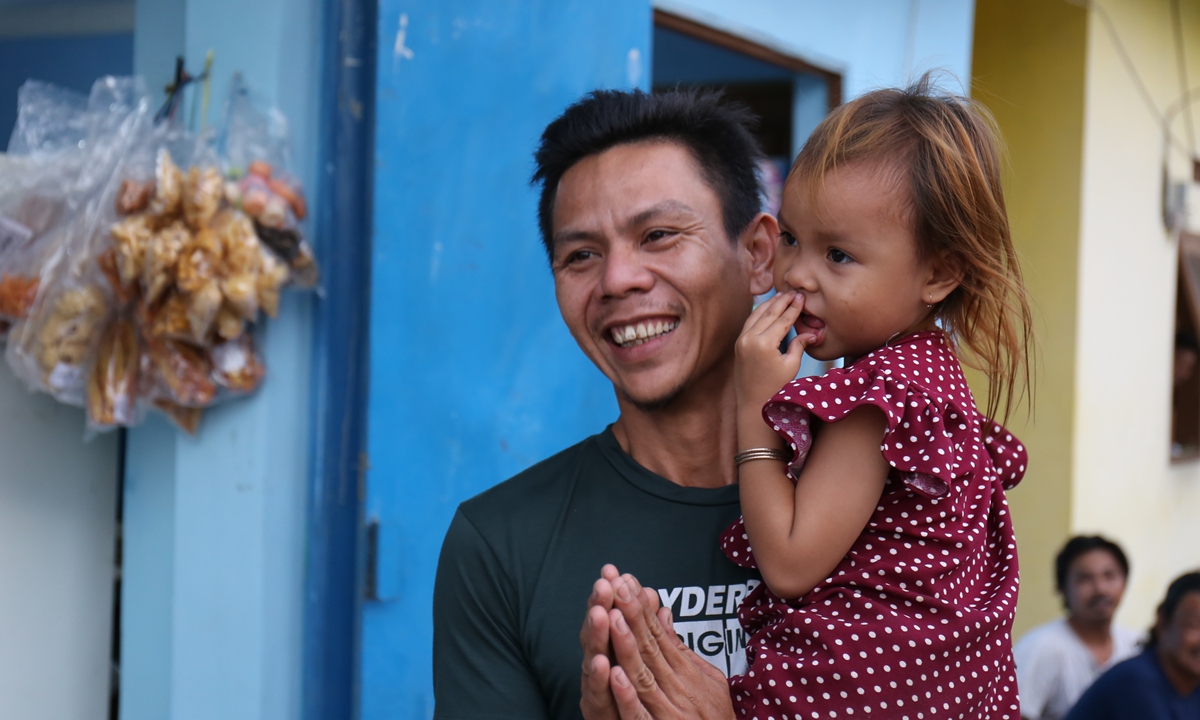
A local villager near Tegalluar Station in Bandung, Indonesia, expresses his gratitude to Chinese contractors. Photo: Zhao Juecheng/GT
Vicious mindset VS Bright reality
As the US, Japan, and other Western countries increasingly grow restless over the BRI's steady rise, Western media outlets - in collusion with politicians and non-government organizations - have been churning out a flurry of bearish reports on BRI project this year, using sensational headlines and hyping the sheer size of claimed "predatory debt" to discredit normal BRI cooperation.
Japanese media outlet Nikkei Asia published a lengthy piece claiming that the Jakarta-Bandung HSR could mire Indonesia in a "Sri Lanka-like debt trap."
In March, the Voice of America (VOA) concocted the term "Sunk Cost Fallacy Trap," alleging that continuous investment in the HSR, which adds up to the existing cost, will create a huge burden for the Indonesian government, with no way out.
Such stories are simply regurgitations of the "debt trap diplomacy" cliché, propagandist rhetoric loudly trumpeted by a number of Western political figures including former US vice president Mike Pence and former US secretary of the Navy Richard V. Spenser.
But the Global Times reporters' field investigation finds that such clamoring is nothing more than barefaced lies fabricated by the Western media and anti-China politicians. The "debt trap" cliché attack is to politicize ideologize economic issues based on the misrepresentation of the reality on the ground.
"There's a major logic flaw in the 'debt trap' theory because, for any major infrastructure project to kick off, you must borrow, regardless of whether from the US, Japan, or China… That's where the debts come from, and is essentially a normal phenomenon following economic rules. The creation of debt does not amount to a debt crisis," said Zhang.
What's at the core is how the operator calculates how to manage the debt level, and "China is obviously doing a good job" in that regard.
In the case of the Jakarta-Bandung HSR, the project's financing is in the form of commercial loans granted to the joint venture KCIC, rather than sovereign borrowing.
"It is a business-to-business model with risks borne by both the Chinese and Indonesia companies involved, which the Indonesian government is comfortable with," Zhang explained, noting that this model also embodies the BRI concepts of "extensive consultation, joint contribution, and shared benefits."
What's at the core is how the operator calculates how to manage the debt level, and "China is obviously doing a good job" in that regard.
In the case of the Jakarta-Bandung HSR, the project's financing is in the form of commercial loans granted to the joint venture KCIC, rather than sovereign borrowing.
"It is a business-to-business model with risks borne by both the Chinese and Indonesia companies involved, which the Indonesian government is comfortable with as it won't increase its foreign debt," Zhang explained, noting that this model also embodies the BRI concepts of "extensive consultation, joint contribution, and shared benefits."
Wirun Phichaiwongphakdee, director of the Thailand-China Research Center of the Belt and Road Initiative, noted that the frequently hyped profitability and sustainability issues associated with BRI projects are, in fact, "logically deceptive."
"The West has resorted to its common practice of telling fragmented BRI stories and concealing the most important parts, so as to instigate dissatisfaction among the Southeast Asian people and shape stereotypical misperceptions of the BRI in wider scope," Wirun told the Global Times.
In Thailand, hopes for the early opening of the China-Thailand HSR have been floating high, since the operation of the landmark China-Laos Railway BRI project in December 2021 that provides a complete picture of the instilled economic boost, the Global Times learned.
Since construction started, the China-Thailand HSR has often been a target of intensive Western slandering, citing the hefty construction cost that could drive up Thailand's public debt.
"It is hilarious to see how the West tallies the economic books. They only calculate the benefits based on revenue from passenger ticket prices and cargo transportation. This is biased because it should also include the comprehensive income along the economic corridor, including commercial development," Wirun said, while noting that construction of public facilities amid economic slowdown are also an economic stimulus.
With regard to sources where the debts stem from, scholars from Southeast Asian think tanks have stressed that it is neither fair nor objective to blame China, as the majority of debt by developing countries is owed to international multilateral institutions like the IMF and the World Bank, while loans from China only account for a small proportion.
"The debt issue of countries along the BRI route is a result of multi-year accumulation of unsustainable financial distress. It is not the development of the BRI that inflicted the crisis," Yu Hong, senior research fellow at the East Asian Institute at the National University of Singapore, told the Global Times.
Statistics showed that multilateral institutions and commercial creditors account for over 80 percent of BRI countries' debts, the biggest source of their debt burden.
In the case of Sri Lanka, which in Western narrative is portrayed as a "victim of the BRI debt trap," loans from China accounted for only about 10 percent of Sri Lanka's total foreign debt in 2021, roughly the same as Japan, and much less than market borrowings and multilateral development banks, relevant data showed.
If there's anyone to be blamed for debt defaults in Southeast Asian countries, it should be the US whose irresponsible monetary policy drives to strengthen the dollar, which then squeezes the liquidity of developing countries, fuels inflation and increases their debt repayment costs, observers pointed out.
'Sour grapes' mentality
During in-depth talks with locals in Southeast Asian countries including in Thailand, Malaysia, and Indonesia, the Global Times noticed the extensive endorsement on Chinese railway technologies. Various qualities such as construction efficiency, advancement of technologies, the application of Chinese standards and how to apply the experience learned have all been applauded by residents in BRI countries.
Chinese engineers recalled that the competition for infrastructure projects in Southeast Asia can be quite intense in the bidding process, but China has exceeded Japanese and European companies aided by its overwhelming industrial strength.
In the case of the Jakarta-Bandung HSR, a consortium of Chinese companies won the contract over their Japanese counterparts back in 2015, Zhang noted.
"To the envy of Western countries, China has undertaken numerous BRI infrastructure construction projects across Southeast Asia. So their vilification against BRI projects could be out of a 'sour grapes' mentality," the anonymous executive said.
Chinese project managers also stressed that Chinese investments come with great sincerity, without any terms attached and are there for the long term, which is the nature of BRI cooperation.
China's long-term pledge was on vivid display when the Global Times visited the construction site of the East Coast Rail Link (ECRL) in the Kemasul Forest Reserve. The railway passes through this forest reserve, which serves as a habitat for various wild animals, including Asian elephants, wild boars, black panthers, and bears.
At the site, numerous culverts of different sizes have been designed to accommodate the wildlife. Some of these culverts are approximately 6 meters wide and 5 meters high, allowing for adult elephants and other forms of wildlife to pass underneath the railway during the construction phase.
Gao Xiaoyue, the environmental manager of the China Communications Construction Company (CCCC) ECRL Section 6, told the Global Times that once the railway is completed, they will restore the land and animal habitats to the best of their ability, in accordance with the requirements of the local authorities.
Observers said that the Western accusations against BRI projects are fraught with hypocrisy mindsets. For example, US investment depletes local resources for the sake of reaping short-term gains and demands strong obedience to the political terms attached, which would leave recipients firmly under Washington's thumb.
The US is interpreting the China-proposed public good from its own past coercive exercises, Chinese analysts said. By contrast, BRI investment truly generates new growth engines, and supports the self-sustainable development needs of countries along the BRI route.
MarzukiAlie, former speaker of the People's Representative Council of Indonesia, told the Global Times that the Jakarta-Bandung HSR project has exhibited a number of observable aspects, including "technology transfer that contributes to the overall growth of Indonesia's transportation and technology … and a positive impact on the growth of tourism and the regional economy."
"China and Southeast Asia are both developing countries, which means they understand each other better and can easily accommodate each other's complementary economic development demands," Wirun explained.
The denigration of China's strengthened BRI cooperation with Southeast Asian countries is based on Western-centric thinking meant to maintain the unipolar hegemonic order under US domination. But the vibrant BRI feats achieved won't be derailed by vicious Western attacks, as the world is growing tired of US coercion and increasingly desires a different, multipolar order, analysts said.
"We know what is best for us… And I would suggest that some countries not interfere and create chatter about China-ASEAN cooperation [under the BRI]," Wirun noted.


